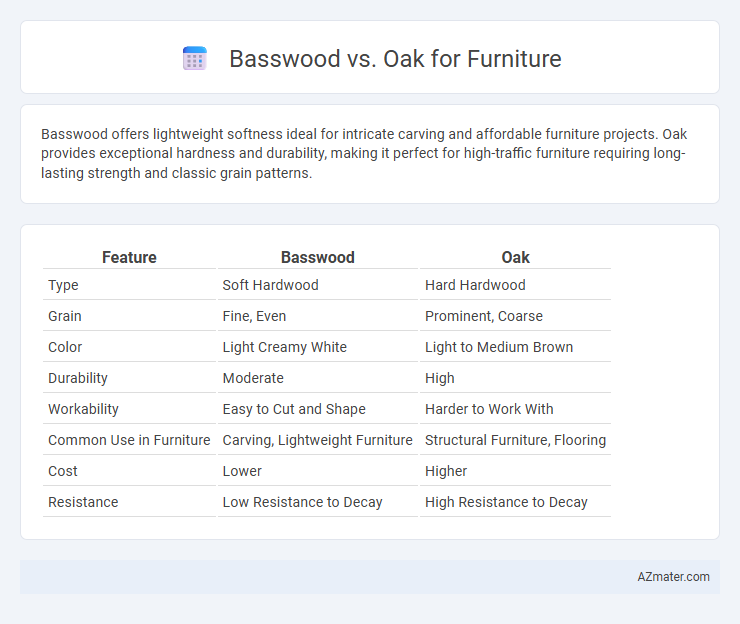Basswood offers lightweight softness ideal for intricate carving and affordable furniture projects. Oak provides exceptional hardness and durability, making it perfect for high-traffic furniture requiring long-lasting strength and classic grain patterns.
Table of Comparison
| Feature | Basswood | Oak |
|---|---|---|
| Type | Soft Hardwood | Hard Hardwood |
| Grain | Fine, Even | Prominent, Coarse |
| Color | Light Creamy White | Light to Medium Brown |
| Durability | Moderate | High |
| Workability | Easy to Cut and Shape | Harder to Work With |
| Common Use in Furniture | Carving, Lightweight Furniture | Structural Furniture, Flooring |
| Cost | Lower | Higher |
| Resistance | Low Resistance to Decay | High Resistance to Decay |
Introduction: Choosing Between Basswood and Oak for Furniture
Basswood offers a lightweight, smooth texture ideal for intricate carving and painted finishes, making it popular in detailed furniture pieces. Oak provides exceptional durability, a prominent grain pattern, and natural resistance to wear, suited for sturdy, long-lasting furniture. Selecting between basswood and oak depends on desired aesthetics, structural strength, and intended furniture use.
Wood Characteristics: Basswood vs Oak
Basswood features a lightweight, soft texture with fine, even grain, making it easy to carve and ideal for intricate furniture designs. Oak is a hardwood known for its strength, durability, and prominent grain patterns, offering excellent resistance to wear and heavy use in furniture. Basswood's pale color contrasts with oak's natural warm hues, influencing aesthetic choices in furniture production.
Hardness and Durability Comparison
Basswood has a Janka hardness rating of approximately 410, making it a relatively soft wood suitable for intricate carving but less resistant to dents and scratches. Oak, with a Janka hardness between 1,200 and 1,360 depending on the species (red or white oak), offers significantly higher durability and wear resistance, making it ideal for high-traffic furniture. The superior hardness of oak ensures better longevity and structural integrity compared to the softer basswood in furniture applications.
Appearance and Grain Patterns
Basswood features a light, creamy color with a fine, uniform grain that creates a smooth, subtle appearance ideal for painted or stained finishes. Oak displays a more prominent, coarse grain with distinctive rays and flecks, offering a rich texture and warm, natural hues ranging from light to medium brown. The bold grain patterns of oak provide a rustic, traditional aesthetic, contrasting with basswood's understated elegance and versatility in design.
Workability and Ease of Crafting
Basswood is highly favored for furniture making due to its excellent workability, as it is soft, lightweight, and easy to carve or shape with hand and power tools. Oak, while denser and harder, requires more effort to craft but offers superior durability and a prominent grain that adds character to the finished piece. The choice between basswood and oak depends on the furniture maker's need for ease of crafting versus long-term strength and aesthetic appeal.
Weight and Density Differences
Basswood features a low density of approximately 22-26 lbs/ft3, making it significantly lighter than oak, which typically ranges from 42-47 lbs/ft3. This weight difference impacts furniture construction, with basswood offering ease of handling and transport, while oak provides greater sturdiness and durability due to its higher density. Oak's density contributes to enhanced resistance to wear and structural support, making it ideal for heavy-use furniture compared to the more lightweight and softer basswood.
Cost and Availability of Basswood and Oak
Basswood is generally more affordable than oak, making it a cost-effective choice for furniture projects with budget constraints. Oak is widely available in both red and white varieties, often commanding a higher price due to its durability and classic grain pattern. While basswood is more readily found in specialty woodworking stores, oak is commonly stocked by most lumber suppliers and home improvement centers.
Finishing and Staining Qualities
Basswood offers a smooth, even grain that absorbs stains uniformly, creating a consistent finish ideal for detailed or painted furniture pieces. Oak, with its open grain and natural resistance, takes stains unevenly but enhances wood character, producing rich, varied tones and pronounced grain patterns. Choosing between basswood and oak depends on the desired aesthetic: basswood suits fine, light finishes while oak excels in showcasing deep stains and textured looks.
Best Use Cases for Basswood and Oak Furniture
Basswood is ideal for intricate wood carvings, lightweight furniture, and interior applications due to its fine grain, softness, and ease of shaping. Oak, known for its durability, hardness, and resistance to wear, excels in heavy-use furniture like dining tables, flooring, and cabinetry. Choosing between basswood and oak depends on whether the furniture requires delicate detailing or long-lasting sturdiness for high-traffic environments.
Conclusion: Which Wood Is Better for Your Furniture Project?
Basswood offers lightweight durability and smooth workability, making it ideal for intricate carving and painted finishes in furniture projects. Oak provides superior strength, natural grain patterns, and exceptional resistance to wear, which suits heavy-use furniture requiring longevity. Choose basswood for detailed, delicate designs and oak for robust, long-lasting pieces with a classic hardwood appearance.

Infographic: Basswood vs Oak for Furniture
 azmater.com
azmater.com